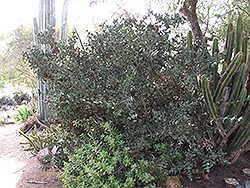It's all about ...
plants

Height: 8 feet
Spread: 12 feet
Sunlight:
![]()
Hardiness Zone: 8b
Other Names: Crucifixion Thorn, Jet Plane Plant
Description:
A slow growing evergreen shrub, developing woody main stems; the flat, leaf-like stems are photosynthetic and very spiny; true leaves are tiny and only on new growth; not recommended near walkways
Ornamental Features
Anchor Plant features showy fragrant creamy white bell-shaped flowers along the branches from early to mid fall. It has dark green evergreen foliage. The small round leaves remain dark green throughout the winter.
Landscape Attributes
Anchor Plant is a multi-stemmed evergreen shrub with an upright spreading habit of growth. Its relatively coarse texture can be used to stand it apart from other landscape plants with finer foliage.
This shrub will require occasional maintenance and upkeep, and should only be pruned after flowering to avoid removing any of the current season's flowers. It is a good choice for attracting bees and butterflies to your yard, but is not particularly attractive to deer who tend to leave it alone in favor of tastier treats. Gardeners should be aware of the following characteristic(s) that may warrant special consideration;
- Spiny
Anchor Plant is recommended for the following landscape applications;
- Accent
- Mass Planting
- Hedges/Screening
- Container Planting
Planting & Growing
Anchor Plant will grow to be about 8 feet tall at maturity, with a spread of 12 feet. It has a low canopy, and is suitable for planting under power lines. It grows at a slow rate, and under ideal conditions can be expected to live for 50 years or more.
This shrub should only be grown in full sunlight. It prefers dry to average moisture levels with very well-drained soil, and will often die in standing water. It is considered to be drought-tolerant, and thus makes an ideal choice for xeriscaping or the moisture-conserving landscape. It is not particular as to soil pH, but grows best in sandy soils. It is somewhat tolerant of urban pollution. This species is not originally from North America.
Anchor Plant makes a fine choice for the outdoor landscape, but it is also well-suited for use in outdoor pots and containers. With its upright habit of growth, it is best suited for use as a 'thriller' in the 'spiller-thriller-filler' container combination; plant it near the center of the pot, surrounded by smaller plants and those that spill over the edges. It is even sizeable enough that it can be grown alone in a suitable container. Note that when grown in a container, it may not perform exactly as indicated on the tag - this is to be expected. Also note that when growing plants in outdoor containers and baskets, they may require more frequent waterings than they would in the yard or garden. Be aware that in our climate, most plants cannot be expected to survive the winter if left in containers outdoors, and this plant is no exception. Contact our experts for more information on how to protect it over the winter months.
This plant is not reliably hardy in our region, and certain restrictions may apply; contact the store for more information.
